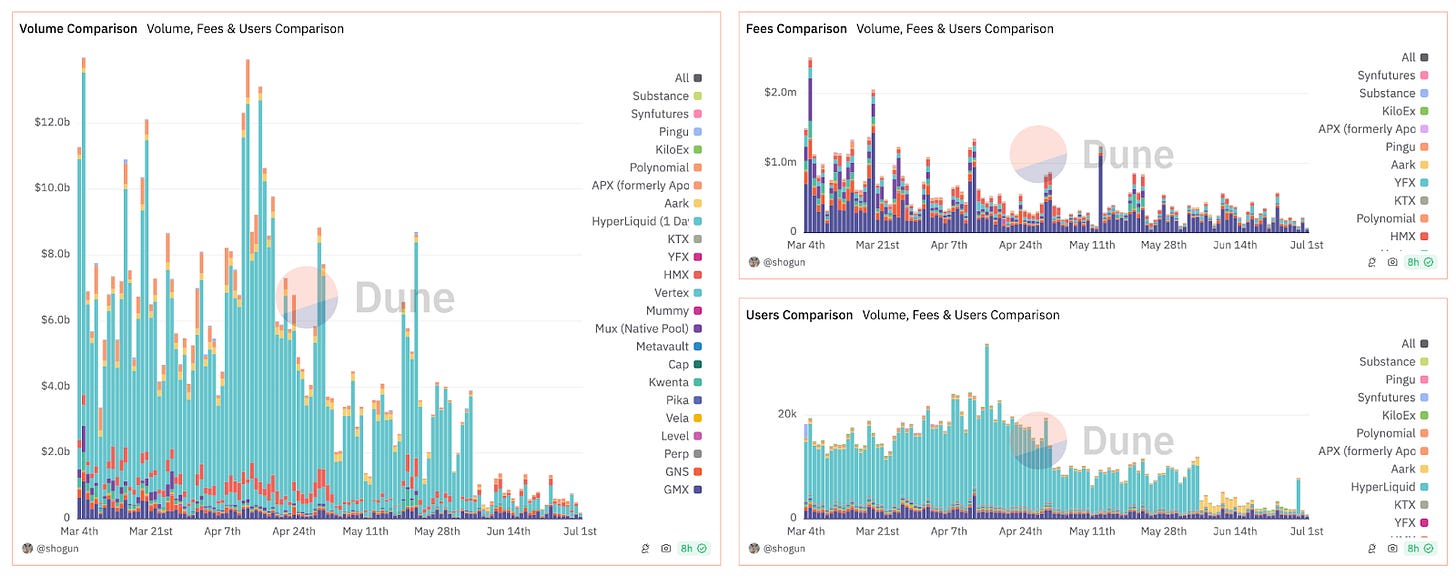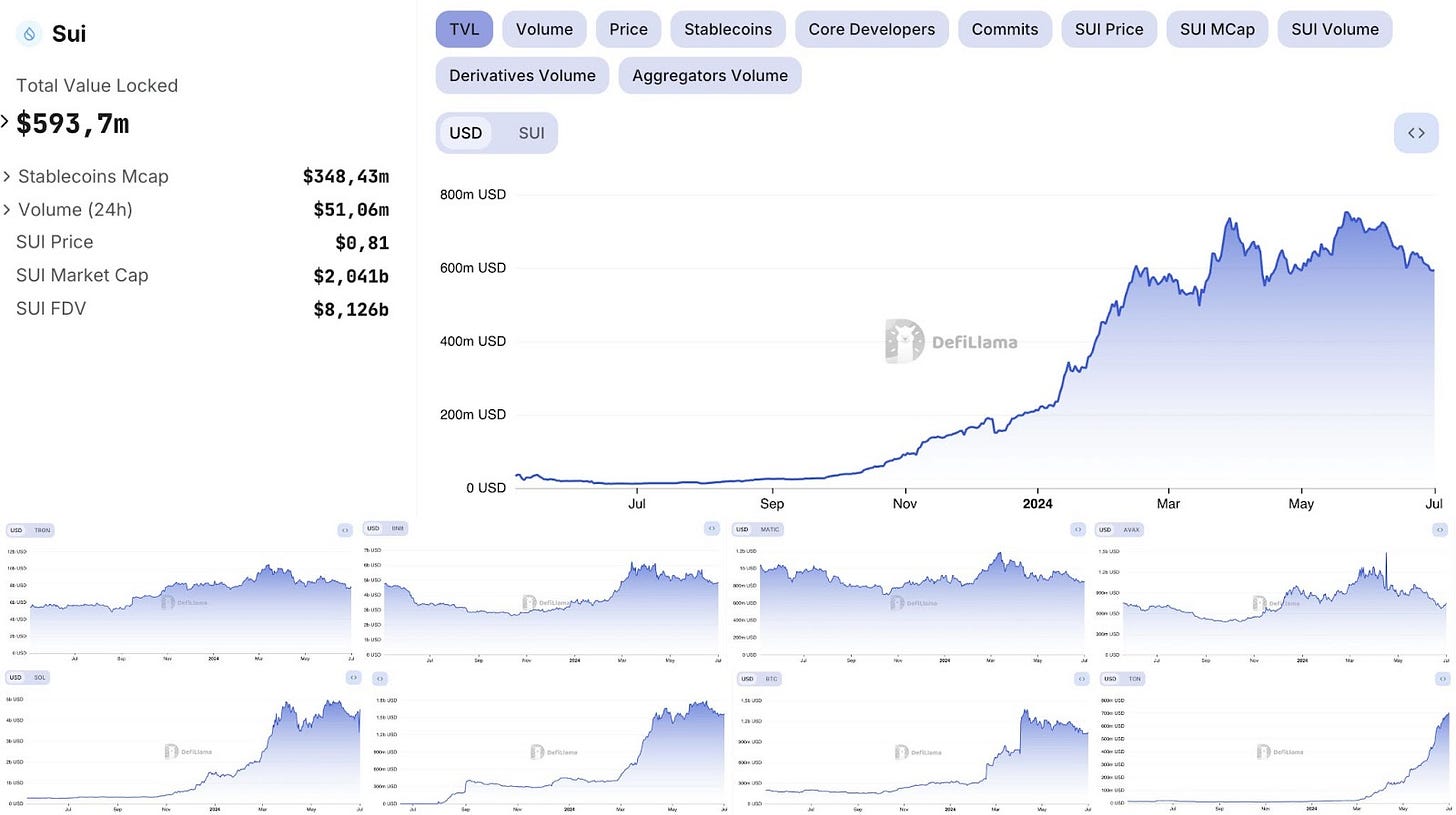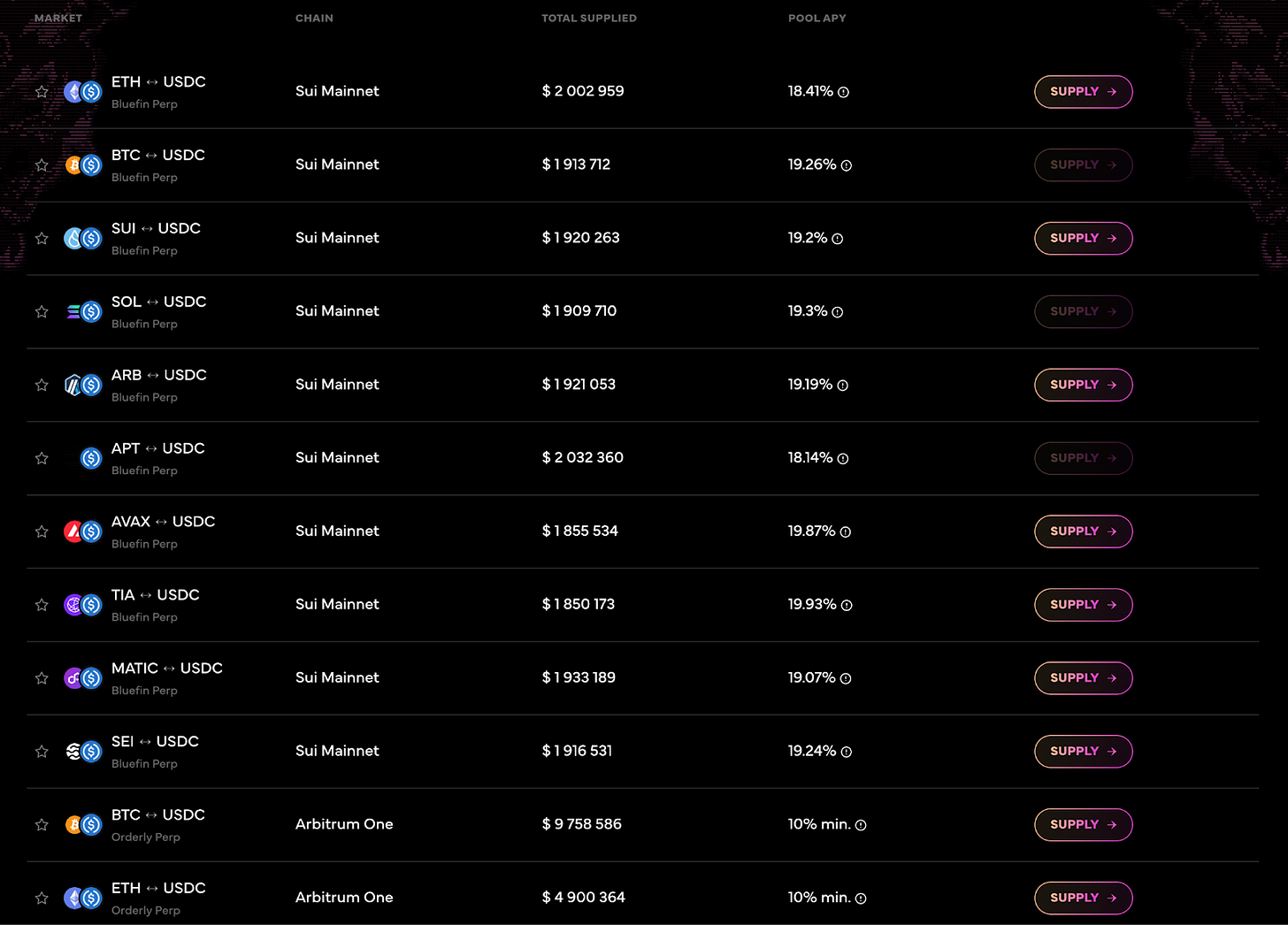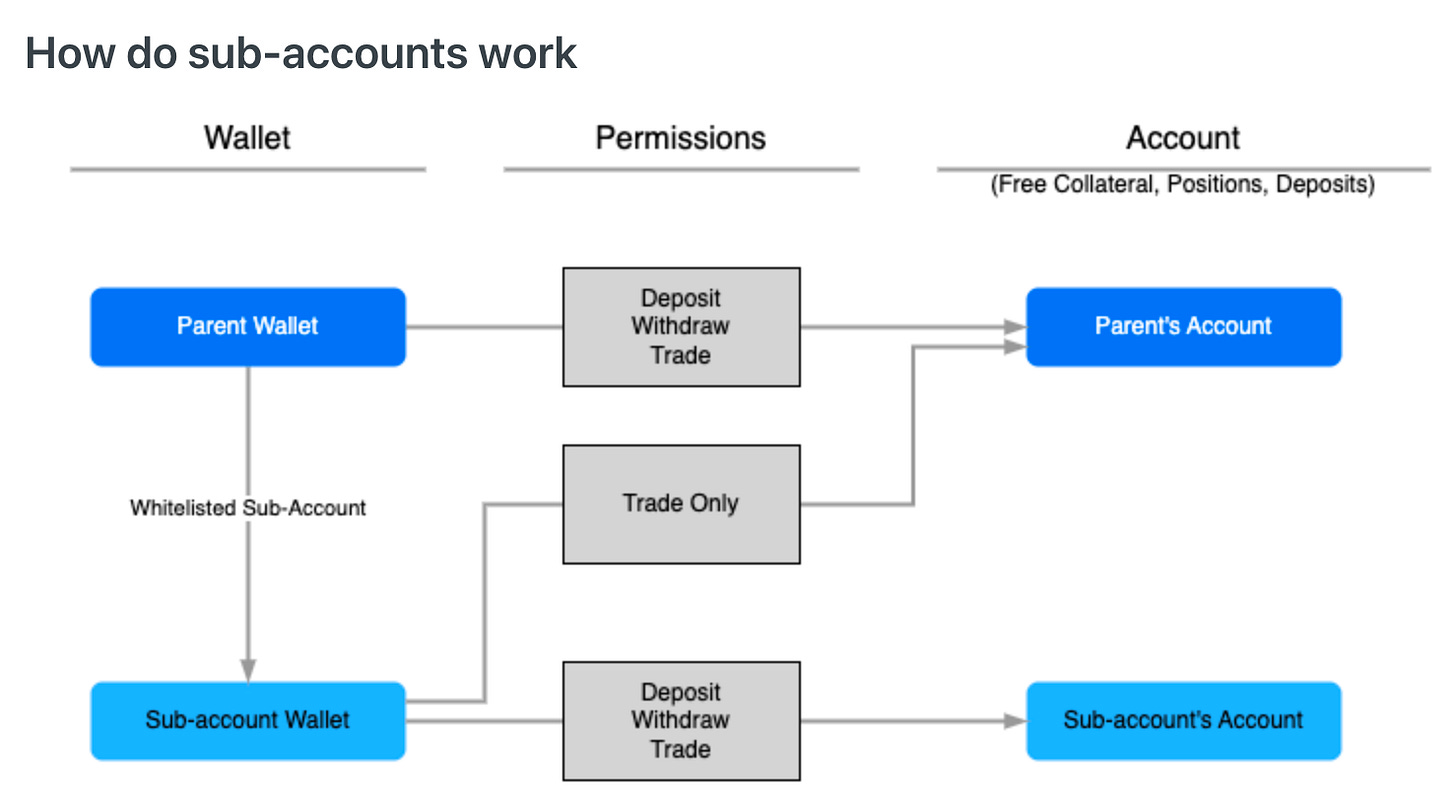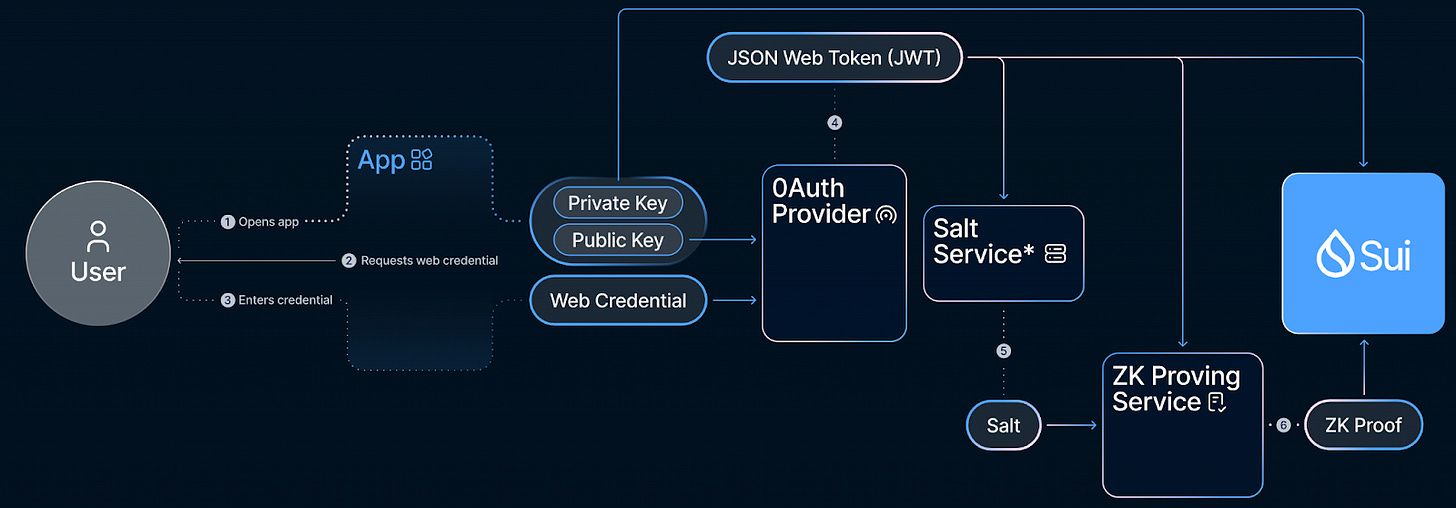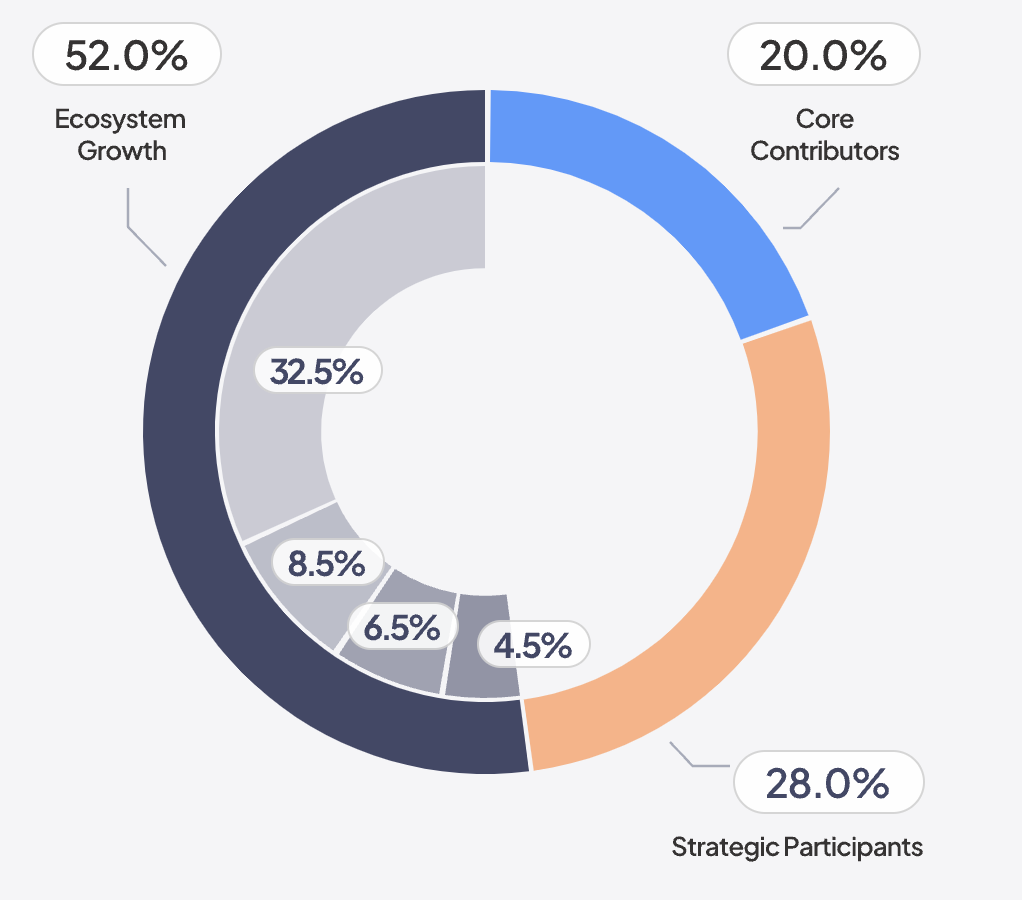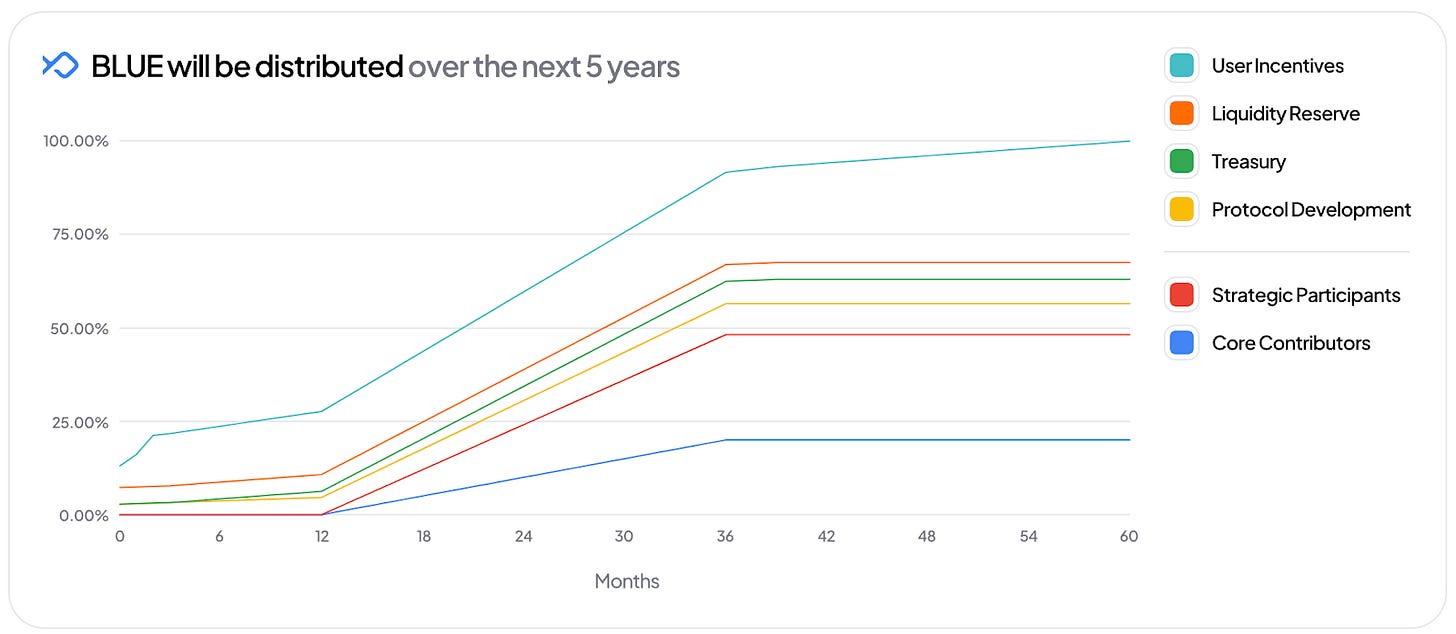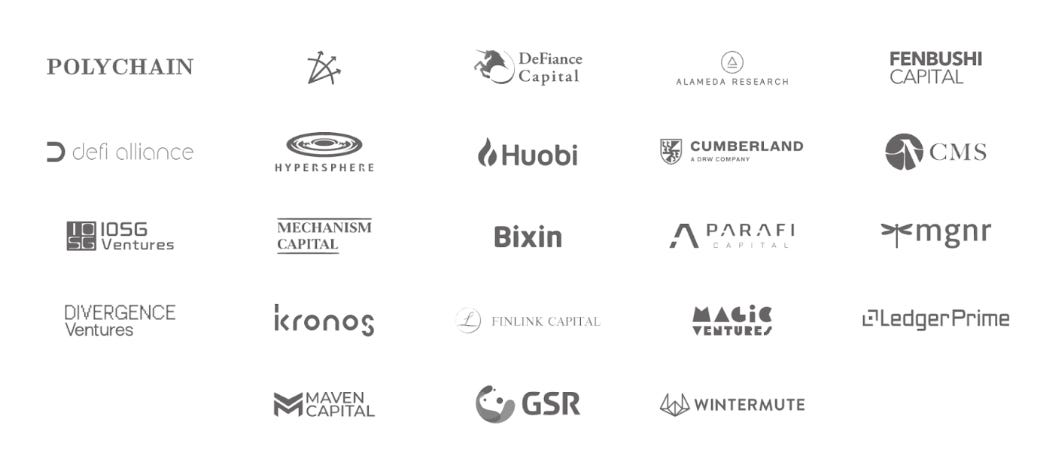Bluefin Explained: New Generation of Orderbook-based DEX
Market overview of perpetual DEXes and CLOB-based DEX with features such as sub-accounts, zkLogin, AA, all orders off mode, read-only-token and others.
Disclaimer: The content presented in this article, along with others, is based on opinions developed by the analysts at Dewhales and does not constitute sponsored content. At Dewhales, we firmly adhere to a transparency-first philosophy, making our wallets openly available to the public through our website or DeBank, and our articles serve as vehicles for self-expression, education, and contribution to the ecosystem.
Dewhales Capital does not provide investment advisory services to the public. Any information should not be taken as investment, accounting, tax or legal advice or as a recommendation to purchase, sell or hold or to pursue any investment style or strategy. The accuracy and appropriateness of the information is not guaranteed by Dewhales Capital.
1. Introduction
2. Perpetuals landscape and the background to Bluefin
3. Bluefin Overview
3.1 Bluefin's development trajectory
3.2 How orders work under the hood
3.3 Sub-accounts
3.4 Cancel All Orders on Disconnect (Dead Man's Switch)
3.5 zkLogin
3.6 One-Click Trading
3.7 Read-only-token
3.8 Market Maker Program
4. Tokenomics and metrics
5. Partnerships and integrations
6. Backers
7. Conclusion
1. Introduction
Today, we have a project from a highly competitive niche - Bluefin, a CLOB-based perpetual DEX. Bluefin boasts several key features that set it apart from other solutions. The CLOB mechanism provides traders with minimal latency and the ability to place orders without gas fees, enhancing the speed and user experience to rival centralized exchanges (CEX). Other key features include the implementation of sub-accounts on the on-chain exchange, customizable order cancellation parameters, zk-login, a mechanism for providing read-only account access similar to centralized solutions, and much more.
2. Perpetuals landscape and the background to Bluefin
Before diving into a detailed review of Bluefin, it's essential to look at the current state of the on-chain perpetual DEX market. CEXes are competing to offer the lowest fees, deep liquidity, and fast execution. The key question is whether decentralized exchanges (DEXs) can compete with such strong offerings. Historical volumes indicate that in the spot markets, there's a noticeable shift of users from CEXes to DEXes, reflecting a steadily growing interest in on-chain trading. A particularly significant spike occurred in late spring to early summer of 2024.
To make the following material easier to understand, let’s recall what perpetuals and perp DEXes are:
Perpetual swaps, unique to cryptocurrencies, are financial products essentially representing futures contracts without an expiration date. They can operate on short or long positions at any time as long as they maintain their collateral. Since perpetual contracts require borrowed funds or leverage, traders use collateral to keep the position open. The minimum collateral requirement is the maintenance margin.
A perp DEX is a decentralized exchange facilitating the trading of these perpetual futures with high liquidity.
Furthermore, data from Keyrock indicates that activity on perpetual CEXs began to increase at the start of 2024. Data from TheBlock shows that the most intense growth in activity on perpetual DEXs began in the fall of 2021. Meanwhile, the volume of perpetual contracts on CEXs started growing two years earlier, increasing 25-fold from 2019 to 2021. Additionally, comparing the graphs reveals that when perpetual DEXs emerged, volume began shifting from CEXs to DEXs in the summer of 2021.


However, DeFiLlama, which aggregates on-chain data across all chains and includes data from a significantly larger number of protocols, presents a contrasting picture—demand for such instruments has grown significantly. This is especially evident when compared to the graph from The Block, which includes data from dYdX, Synthetix, GMX, and Perpetual Protocol. At the peak in October 2021, the monthly volume was $107.7b, whereas, during the peak activity in March 2024, it had reached $316b.
But here's where things get interesting with Bluefin. On one hand, on-chain dashboards on Dune, which include data from various protocols, show a decline in volumes on perpetual DEXes over the past six months. Meanwhile, the graphs above indicate that perpetual CEX volumes started to grow at the beginning of 2024. Based on these observations, it's reasonable to assume that changes in on-chain perp market activity lag behind the overall perpetual market. Additionally, the constant emergence of new technologies and implementations in the decentralized world also creates a time lag and liquidity shift to new platforms and protocols.
On the other hand, if we look at Bluefin's metrics, there are no signs of such a significant decline. Instead, TVL and the number of users are increasing:
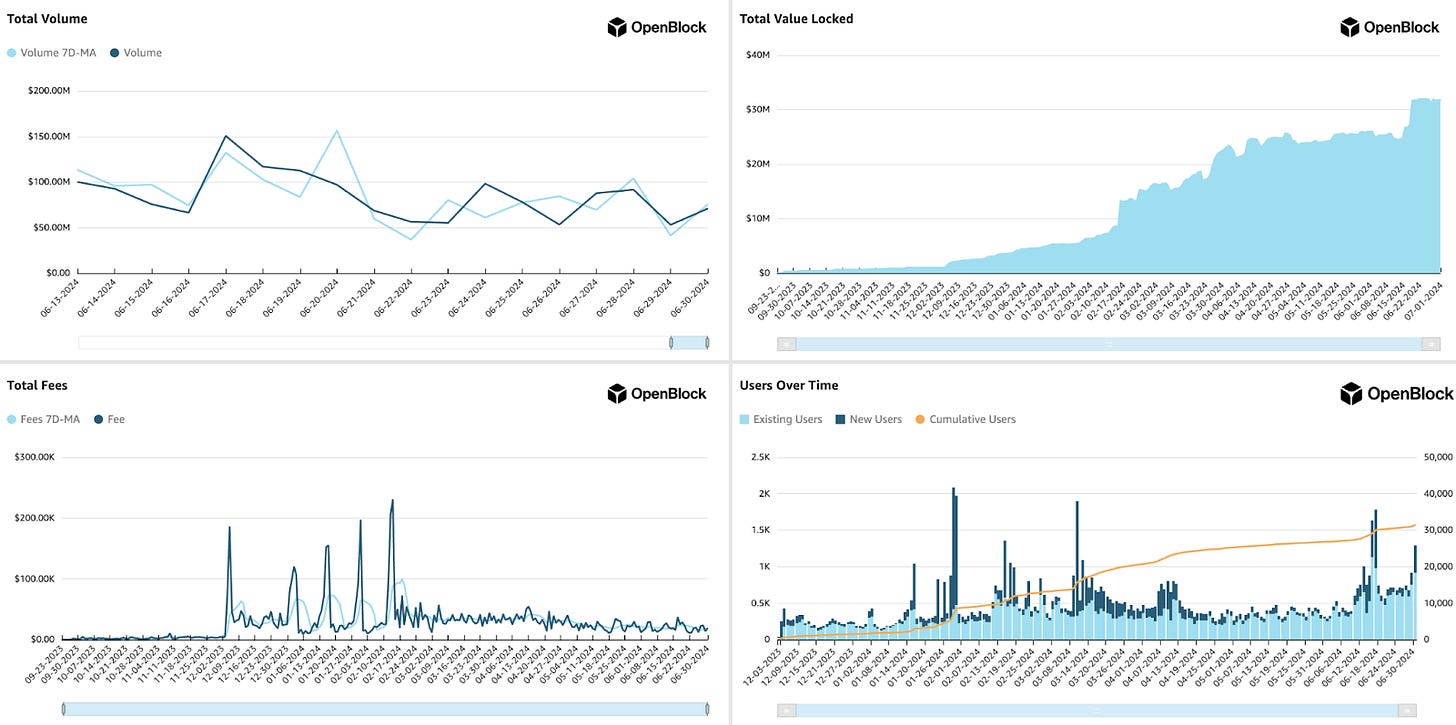
Why is this happening? There are several reasons:
First, Bluefin is pursuing a strategy focused on capturing a user base, including through partnerships with various projects in the Sui ecosystem and joint events with them.
Second, the Sui ecosystem has been able to capitalize on the growing trend of new ecosystems and has started to increase user and liquidity inflows, unlike some other, larger ecosystems. In the upcoming Sui Mysticeti update, the finalization time is expected to decrease from the current 510ms to 390ms. Additionally, the competitive landscape in Sui provides good initial positions compared to the more saturated ecosystems of Ethereum and its rollups, filled with other EVM-based chains:
Third, Bluefin offers users not only unique features, which we will discuss below, but also years of development and refinement experience. Bluefin's development began in 2021 when the team initially planned to launch in the Polkadot ecosystem and actively built a network of partnerships there. However, they later shifted their focus to Arbitrum, attracted by its large and active liquidity. The team continues to expand, capturing new territories, liquidity, and users. Thus, Bluefin has gone through several iterations: from v1 on Arbitrum, v2 on Sui, to Bluefin Pro with Wormhole Connect integration, which is currently in the process of launching (expected in September 2024).
Additionally, Bluefin offers superior liquidity depth and profitability conditions, as seen on the perp aggregator Elixir (which we have reviewed separately):
Moreover, Bluefin, according to the team, is already generating monthly revenues exceeding $1m, despite having relatively low fees. Specifically, the fee structure on Bluefin is 0.035% for takers and 0.010% for makers. These fees are computed based on the notional value traded and are charged in USDC. Additionally, the Bluefin Foundation covers gas fees for users, even though the average gas cost is around $0.01 with minimal deviation.
"Our goal is to accelerate the adoption of decentralized finance by bringing a sustainable, powerful, and user-friendly exchange to the market," - said Zabi Mohebzada, co-founder of Bluefin.
3. Bluefin Overview
3.1 Bluefin's development trajectory
Bluefin's development began in 2021, when the team initially planned to launch in the Polkadot ecosystem and actively built a network of partnerships there. However, they later shifted their focus to Arbitrum, attracted by its large and active liquidity. The team continues to expand, capturing new territories, liquidity, and users. As a result, Bluefin has undergone several iterations:
V1: Bluefin Classic - Initially launched on Arbitrum. Notably, during the transition from one version to another, all open positions were settled at the closing price, and the team provided time for fund withdrawal.
V2: Bluefin on Sui - From September 2023 to January 2024, Bluefin V2 processed a trading volume of over $2.3b. By December 2024, it reached $3.2b, and by June 21, 2024, Bluefin V2 had processed $20b. This version introduced features like zkLogin, wallet-free trading, integrated bridges, and one-click trading. Sui was chosen for its advantages, such as not requiring global transaction ordering, supporting parallel execution, having ~480 ms finalization time, and achieving an average end-to-end transaction confirmation time of ~510 ms in production benchmarks.
V3 or Bluefin Pro - Developed in collaboration with Axelar and Wormhole using Wormhole Connect. Wormhole is a primary bridge for the Sui Network, with 56% of assets (almost $129m) transferred from Ethereum to Sui via Wormhole from May 21 to June 21. Bluefin V3 will ensure off-chain trade confirmations in under 30 ms, on-chain transaction finalization in under a second (approximately 400 ms), and throughput up to ~30,000 transactions per second (TPS). Bluefin's fast trade execution contributes to its month-over-month volume growth.
At its core, Bluefin operates as a CLOB (Central Limit Order Book). Order books offer several advantages over Automated Market Makers (AMMs), allowing professional and institutional traders to leverage their existing infrastructure and trading strategies on the exchange. This facilitates the integration of institutional liquidity and flow. Institutional investors, high-frequency traders (HFTs), and automated traders can access Bluefin’s high-performance exchange through its API and SDK.
Bluefin's future plans include additional functionalities to capture more liquidity, users, and chains with increasing offering beyond perpetuals:
-Decentralized off-chain order book on Sui: implementing a network of nodes responsible for maintaining and updating the order book for the Sui DEX, with nodes selected via Bluefin’s governance system to ensure trust minimization.
- Governance mechanisms: implementing governance mechanisms that allow the community to participate in the decision-making process on the platform.
- Cross-chain spot trading with cross-chain liquidity
- Aggregator
- Infrastructure solutions for DeFi
- Users will also be able to provide Bluefin credits to leading market makers through Bluefin Stable Pools.
3.2 How orders work under the hood:
Bluefin utilizes an off-chain order book and on-chain settlements. Therefore, orders are submitted via the API endpoint POST /order in Bluefin, rather than directly on-chain. These orders are routed through a matching engine and submitted on-chain once matched.
Since orders are submitted on-chain using the matching engine, order signing is crucial to authenticate the user's request on-chain. After creating the order signature (by signing the order fields using your private key), the orderSignature field is passed as a payload parameter to the POST /order endpoint.
Importantly, for submitting orders via the API, you can use any other language or library capable of making HTTP requests. This means Bluefin offers broad integration capabilities.
To form price data, Bluefin uses two types of price streams to obtain the value of perpetual contracts in US dollars across various functions of its platform: Oracle Price and Index Price. These price streams play a critical role in the platform's proper functioning, ensuring accurate calculations and triggering specific actions.
The Index Price is a volume-weighted average of spot prices from leading exchanges, aggregated and updated every few seconds. It is used for calculating unrealized PnL, triggering stop orders, and calculating funding rates.
The Oracle Price initiates liquidations, calculates interim funding payments, and protects traders from placing orders at prices far from the market. Bluefin V2, deployed on the Sui network, utilizes Oracle price feeds powered by the Pyth network.
3.3 Sub-accounts
Sub-accounts allow delegating trading authority to other wallets, enabling the separation of responsibilities and more secure management of deposited funds. In essence, a sub-account is an address that has been granted permission to trade on positions held in the Main Account within specific markets. Here's how it works:
Due to the peculiarities of blockchain technologies and DeFi, each wallet holds its own funds and positions on the blockchain. A sub-account is a wallet that has permission to sign trading actions on behalf of the Main Account wallet within specific markets, but it does not have the ability to withdraw or deposit funds to the Main Account wallet.
Wallet owners can generate a read-only token that grants access to their data within an institution or to trusted users by transferring this token. At any given time, a wallet owner can have only one active read-only token.
3.4 Cancel All Orders on Disconnect (Dead Man's Switch)
The "Cancel All Orders on Disconnect," also known as the "Dead Man's Switch," is a security mechanism for API traders. It's designed for unexpected network connection issues or updates requiring exchange downtime. This feature allows traders to cancel outdated orders in case of connectivity problems, ensuring confidence in tighter spreads, larger quote volumes, and extended market presence.
The "Dead Man's Switch" cancels all open orders of an API trader upon detection of a network disconnect, both from the user's side and within the system.
Internal Health Checks: The system continuously monitors service states to detect internal connectivity issues.
External Countdown Timer: Each market employs a countdown timer set and reset by the API trader. If not reset and it reaches zero, the timer triggers the "Dead Man's Switch" function.
3.5 zkLogin
zkLogin represents a significant advancement in the Web3 user experience. It simplifies user interaction with dApps by allowing them to log in via social login methods (such as Google). Now, users can interact with Bluefin v2 and v3 without the need to manage an additional set of private keys or mnemonics. zkLogin is one of Sui's native tools designed to facilitate interactions with dApps.
In essence, thanks to Account Abstraction, Bluefin can offer users the ability to register, deposit funds, and trade using just their Google account, bringing a familiar Web2 experience to the table.
What zk-login offers and how it works:
zkLogin creates user accounts using familiar OAuth credentials. Users are prompted to log in using their web credentials. This information is used to generate a JSON web token (JWT), which is then combined with random data (called salt) and passed to a service that generates a zero-knowledge proof (ZKP). The ZKP confirms that the user is the legitimate owner of the account without revealing the actual credentials on-chain. Once the account is created, future transactions can be signed by the user's OAuth account.
Asset self-management: zkLogin transactions require user approval via social login while maintaining the integrity of asset self-management that Web3 users are accustomed to.
Security: zkLogin operates as a two-factor authentication scheme. Sending a transaction requires verification from the social login provider and some randomness (salt) that is inaccessible to the provider. An attacker who compromises the social login cannot execute transactions from the corresponding Sui user address without separately obtaining the salt value.
Confidentiality: Zero-knowledge proofs prevent third parties from linking Sui addresses with corresponding social login data, ensuring user privacy.
3.6 One-Click Trading
This feature works thanks to Account Abstraction, significantly simplifying user interaction with Bluefin by reducing the number of necessary actions without complex setup processes:
Users see the "1 Click Trading" icon directly in the interface, which initiates the setup process.
Upon clicking, a transaction is signed - users are prompted to execute a one-time transaction for approval. This transaction is necessary to authorize the creation of a secure private key for order signing. Once confirmed, the feature is activated.
Subsequently, users with 1 Click Trading enabled can place or cancel orders with just one click or minimal interaction. The system automatically uses the approved private key to sign the required transactions.
3.7 Read-only-token
Another interesting feature is the implementation of the Read-only API, similar to API keys on centralized exchanges (CEX). Wallet owners can generate a read-only token that grants access to their data within the institution or to trusted users by transferring this token. At any given time, a wallet owner can have only one active read-only token. This token remains valid until the owner decides to revoke it.
In essence, this allows users who are not wallet owners to access wallet owner data through API endpoints and WebSocket events.
4. Tokenomics and metrics
Unlike most projects, Bluefin's current tokenomics stands out for its simplicity and conciseness, devoid of complex mechanics. The BLUE token will be used to govern the protocol in key decision-making processes such as protocol upgrades, fee structures, and asset listings. Over time, the DAO will assume more responsibility for decisions impacting the protocol. To submit a proposal, participants must hold 10,000,000 BLUE tokens to qualify for voting rights.
The maximum supply of BLUE tokens will be 1 billion, with an initial circulating supply of 116 million tokens.
32.5% - User Incentives, vesting - over 5 years. 13% for the Bluefin Airdrop which will be given to early point holders and new users. 19.5% for post-launch incentives that reward trading, liquidity provisioning and future growth initiatives. Vesting - over 5 years.
8.5% - Protocol Development, vesting - ⅓ at TGE, ⅔ over 2 years. This portion of the supply is allocated to the Bluefin Foundation’s reserves. Priority initiatives include contracts with service providers like OpenBlock Labs & Chaos Labs, exchange listings, strategic partnerships with DAOs and communities, protocol security, liquidity needs, capitalizing the insurance fund, and operating expenses.
6.5% - Treasury, 3 month cliff, 36-month vesting. This fund is managed by the Bluefin DAO, allowing the community to allocate resources in a way that aligns with Bluefin’s goals and priorities.
4.5% - Liquidity Reserve, Unlocked at TGE. This portion has been reserved for liquidity at launch. 2% of the supply will be given to market makers to quote on centralized exchanges, and about 2.5% of the supply will be used for DEXs and cross-chain liquidity.
28.0% - Strategic Participants, 1 year cliff followed by a 24-month linear unlock. This portion of the supply has been allocated to investors via private sales and advisors. These stakeholders have a long-term vested success in the success of Bluefin, and include leading VCs and quantitative trading firms.
20.0% - Core Contributors, 1 year cliff followed by a 24-month linear unlock. This allocation represents Core Contributors, who have supported the engineering, infrastructure, security, growth, and operations of the Bluefin Protocol.
5. Partnerships and integrations
Axelar - is an overlay network that securely connects many blockchain ecosystems, applications, assets, and users for Web3 interoperability, which Bluefin has chosen to implement cross-chain functionality.
Wormhole - Wormhole pioneered the first generalized message passing protocol, initially connecting Ethereum and Solana. Bluefin began integrating with Wormhole Connect in early 2024. Additionally, the Wormhole community will participate in the upcoming launch of the Bluefin token.
Openblock - is a data-driven platform that fosters growth within decentralized protocols through analytical insights, incentives engineering, and more! They assisted Bluefin in creating Bluefin Metrics.
Chaos Labs - Bluefin closely collaborates with them on mechanism design, risk management, observability, and incentive design.
Throughout Bluefin's lifecycle, partnerships have been key to ensuring liquidity with organizations such as:
Amber Group - a leading global liquidity provider in digital assets, now supporting liquidity across all Bluefin markets. Amber Group specializes in algorithmic liquidity provision and offers digital asset management services and infrastructure. The company has traded over $1 trillion across more than 100 trading venues worldwide and maintains extensive operations across major trading markets.
Wintermute - Wintermute's trading division is currently the leading liquidity provider on Bluefin. Wintermute is also an early investor through Wintermute Ventures.
Keyrock - a digital asset market maker that promotes more inclusive and efficient markets. Founded in 2017 in Brussels, Keyrock's proprietary solutions are deployed on major exchanges, focusing on high-scalable and efficient liquidity provision. Keyrock is one of the liquidity providers on Bluefin.
CrypPro - utilizes its infrastructure and trading algorithms to provide competitive offerings on more than 50 exchanges worldwide and is also a liquidity provider on Bluefin.
Tokka Labs - a strategic partner and proprietary trading firm specializing in quantitative trading of digital assets. The Tokka Labs team has been actively involved in the decentralized space since early 2019. Their experience as proprietary traders supporting other leading protocols and networks enables them to provide exceptional liquidity and efficiency on Bluefin markets.
Kronos Research - a strategic partner on the Bluefin platform. Kronos Research was one of the first institutional participants providing liquidity on the Bluefin Arbitrum order book infrastructure and is a key partner in designing the institutional trading user experience.
Cumberland DRW - a digital asset trading firm within DRW, a proprietary trading firm. As one of the largest liquidity providers in the cryptocurrency space, Cumberland is a valuable partner for Bluefin.
DeFi Alliance - also invested in Bluefin, providing access to institutional liquidity and regulatory support. The Alliance has already connected Bluefin with six market makers from Chicago and Singapore, collectively processing over $22b in daily volume on centralized exchanges, and continues to support Bluefin through its acceleration program.
Currently deployed within the SUI ecosystem, Bluefin is establishing partnerships and jointly incentivizing users through Airdrop initiatives (with 5% of tokens allocated) within this ecosystem with projects such as:
Kriya - users of this protocol will be eligible to receive Bluefin Airdrops.
Scallop - a leading money market on Sui. veSCA holders will be eligible for future Bluefin token Airdrops!
Navi protocol - Bluefin will also distribute a portion of its airdrop among users supporting the NAVI protocol and holding NAVX tokens.
Suilend - a lending and borrowing platform on Sui, built by the experienced team behind Solend. Users on the Suilend leaderboard will be eligible for the Bluefin Airdrop.
Additionally, Bluefin actively builds partnerships across various domains, including enhancing liquidity with web3 communities, among organizations such as Dewhales, Spirit DAO, ARC, Beam, Undefined, KudasaiJP, Azuki, Pudgy Penguins, and others.
It's worth noting that in its early development in 2021, Bluefin was initially named Firefly Protocol and planned to launch within the Polkadot ecosystem. The team actively pursued partnerships in that ecosystem throughout Bluefin's developmental cycle, serving as a cornerstone: partnerships that help attract users and liquidity.
6. Backers
Bluefin is supported by leading companies such as Polychain, SIG, Defiance Capital, Fenbushi Capital, DeFi Alliance, Brevan Howard Digital, IOSG Ventures, Mechanism Capital, GSR, Maven Capital, Wintermute, Huobi, Hypersphere, Morningstar, Divergence Ventures, Tower Research, and others.
To ensure the security of its protocol, Bluefin has conducted several audits with companies such as Trial of Bits, Chaos Labs, Halborn, Quantstamp, Guardrail, Hacken, and OtterSec.
7. Conclusion
The Bluefin team demonstrates great flexibility, understanding of market trends, and quickly adapts to different blockchains and narratives, capturing the entire space step by step. A logical continuation of their expansion strategy is entering cross-chain technologies and introducing new products into Bluefin, which is evolving into a comprehensive Superapp for DeFi.
Another factor worth noting is that Bluefin on Sui, despite its relatively small TVL, already generates over $1m in revenue per month. There aren't many projects that achieve solid revenue generation, and despite the fluctuating demand waves for perpetual DEXes, which peaked towards the end of 2023 and early 2024, with many short-lived solutions appearing on EVM-based chains and rollups, Bluefin continues its progressive development for several years and continues to accelerate its growth.
Bluefin links:
Website | Docs | Twitter | Discord | GitHub | Dashboard
To help us improve and provide you with the best content possible, we'd appreciate it if you could share your thoughts and opinions on the article you just read. Your feedback is very valuable to us and won't take more than 1 minute.
Also, this post is public so feel free to share it post as well
Thank you so much! ❤️




